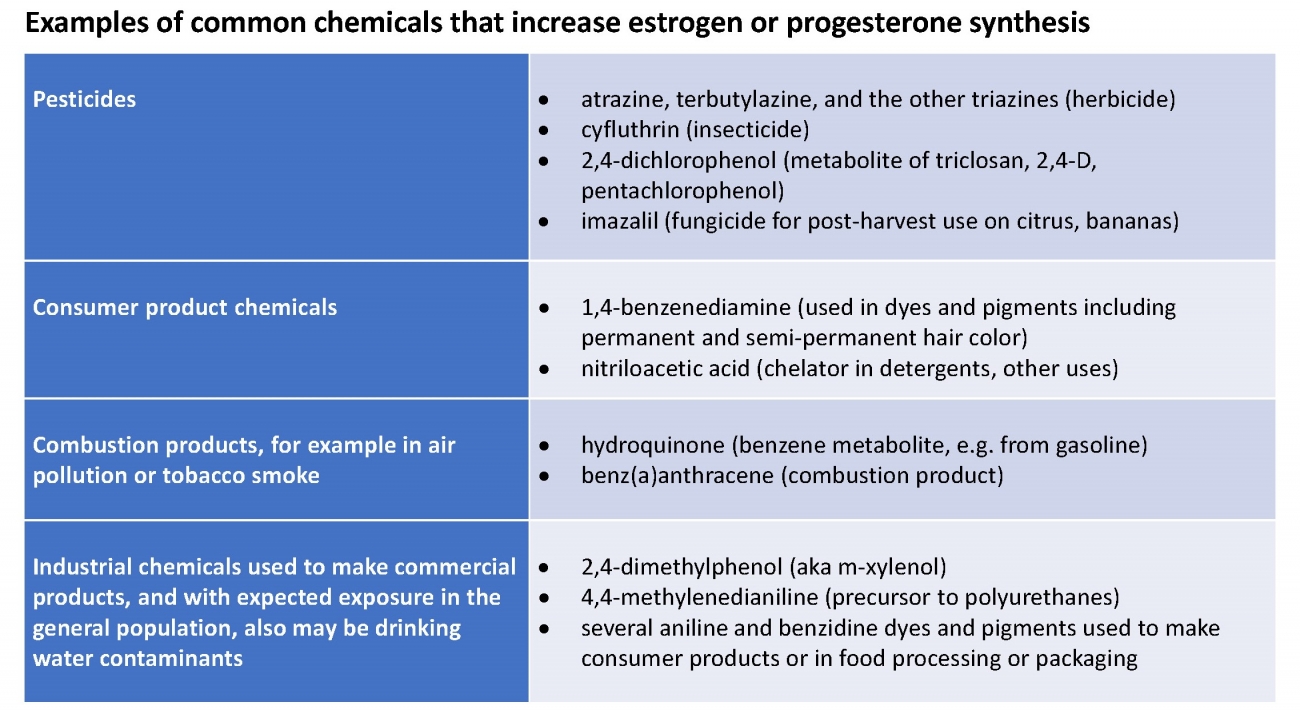Study identifies nearly 300 chemicals, many in consumer products, that could increase breast cancer risk
List includes potential carcinogens that act by stimulating production of hormones that fuel breast tumors
 Every day, people are exposed to a variety of synthetic chemicals through the products they use or the food they eat. For many of these chemicals, the health effects are unknown. Now a new study shows that several hundred common chemicals, including pesticides, ingredients in consumer products, food additives, and drinking water contaminants, could increase the risk of breast cancer by causing cells in breast tissue to produce more of the hormones estrogen or progesterone.
Every day, people are exposed to a variety of synthetic chemicals through the products they use or the food they eat. For many of these chemicals, the health effects are unknown. Now a new study shows that several hundred common chemicals, including pesticides, ingredients in consumer products, food additives, and drinking water contaminants, could increase the risk of breast cancer by causing cells in breast tissue to produce more of the hormones estrogen or progesterone.
“The connection between estrogen and progesterone and breast cancer is well established,” says co-author Ruthann Rudel, a toxicologist and research director at Silent Spring Institute. “So, we should be extremely cautious about chemicals in products that increase levels of these hormones in the body.”
For instance, in 2002, when the Women’s Health Initiative study found combination hormone replacement therapy to be associated with an increased risk of breast cancer, women stopped taking the drugs and incidence rates went down. “Not surprisingly, one of the most common therapies for treating breast cancer is a class of drugs called aromatase inhibitors that lower levels of estrogen in the body, depriving breast cancer cells of the hormones they need to grow,” adds Rudel.
To identify these chemical risk factors, Rudel and Silent Spring scientist Bethsaida Cardona combed through data on more than 2000 chemicals generated by the U.S. Environmental Protection Agency (EPA)’s ToxCast program. The goal of ToxCast is to improve the ability of scientists to predict whether a chemical will be harmful or not. The program uses automated chemical screening technologies to expose living cells to chemicals and then examine the different biological changes they cause.
Reporting in the journal Environmental Health Perspectives, Rudel and Cardona identified 296 chemicals that were found to increase estradiol (a form of estrogen) or progesterone in cells in the laboratory. Seventy-one chemicals were found to increase levels of both hormones. The chemicals included ingredients in personal care products such as hair dye, chemical flame retardants in building materials and furnishings, and a number of pesticides.
The researchers don’t yet know how these chemicals are causing cells to produce more hormones. It could be the chemicals are acting as aromatase activators, for instance, which would lead to higher levels of estrogen, says Cardona. “What we do know is that women are exposed to multiple chemicals from multiple sources on a daily basis, and that these exposures add up.”
The Silent Spring researchers hope this study will be a wakeup call for regulators and manufacturers in how they test chemicals for safety. For instance, current safety tests in animals fail to look at changes in hormone levels in the animal’s mammary glands in response to a chemical exposure. And, although high throughput testing in cells has been used to identify chemicals that activate the estrogen receptor, mimicking estrogen, the testing has not been used to identify chemicals that increase estrogen or progesterone synthesis.
“This study shows that a number of chemicals currently in use have the ability to manipulate hormones known to adversely affect breast cancer risk,” says Dr. Sue Fenton, associate editor for the study and an expert in mammary gland development at the National Institute of Environmental Health Sciences. “Especially concerning is the number of chemicals that alter progesterone, the potential bad actor in hormone replacement therapy. Chemicals that elevate progesterone levels in the breast should be minimized.”
The researchers outlined a number of recommendations in their study for improving chemical safety testing to help identify potential breast carcinogens before they end up in products, and suggest finding ways to reduce people’s exposures, particularly during critical periods of development, such as during puberty or pregnancy when the breast undergoes important changes.
The project is part of Silent Spring Institute’s Safer Chemicals Program which is developing new cost-effective ways of screening chemicals for their effects on the breast. Knowledge generated by this effort will help government agencies regulate chemicals more effectively and assist companies in developing safer products.
Funding for this project was provided by the National Institute of Environmental Health Sciences (NIEHS) Breast Cancer and the Environment Research Program (award number U01ES026130), the California Breast Cancer Research Program, Cedar Tree Foundation, and charitable gifts to Silent Spring Institute.

Resources or References
Reference:
Cardona, B. and R.A. Rudel. 2021. Application of an in vitro assay to identify chemicals that increase estradiol and progesterone synthesis and are potential breast cancer risk factors. Environmental Health Perspectives. DOI: 10.1289/EHP8608
Additional Resources:
Table: Examples of common chemicals that increase estrogen or progesterone synthesis
Invited Perspective: Guyton K.Z. and M.K. Schubauer-Berigan. 2021. Prioritizing Chemical Testing and Evaluation Using Validated in Vitro Assays Relevant to Key Characteristics. Environmental Health Perspectives. DOI: 10.1289/EHP9507